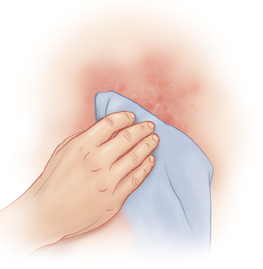Managing Atopic Dermatitis (Eczema)
Managing Atopic Dermatitis (Eczema)
To manage your symptoms and help reduce the severity and frequency, try these self-care tips:
Caring for your skin
Use a gentle, fragrance-free cleanser (or nonsoap cleanser) for bathing. Rinse well. Pat skin dry.
Take warm, not hot, baths or showers. Try to limit them to no more that 10 to 15 minutes.
Use moisturizer liberally right after you bathe, while your skin is still damp.
Avoid scratching because it will cause more damage to your skin.
Topical, over-the-counter hydrocortisone cream may help control mild symptoms.
Controlling your environment
Avoid extreme heat or cold.
Avoid very humid or very dry air.
If your home or office air is very dry, use a humidifier.
Avoid allergens, such as dust, that may be present in bedding, carpets, plush toys, or rugs.
Know that pet hair and dander can cause flare-ups.
Seeking medical treatment
Another way to keep symptoms under control is to seek medical treatment. Talk with your healthcare provider about the type of treatment that may work best for you. Your provider may prescribe treatments such as the following:
Topical treatments to put on the skin daily
Medicines taken by mouth (oral medicines), such as antihistamines, antibiotics, or corticosteroids
In severe cases shots (injections) may be needed to control the symptoms. You may even need antibiotics if skin infections occur.
Treatments don’t work the same way for every person. So if your symptoms continue or get worse, ask your healthcare provider about other treatments.
Making lifestyle choices
Manage the stress in your life.
Wear loose-fitting cotton clothing that does not bind or rub your skin.
Avoid contact with wool or other scratchy fabrics.
Use fragrance-free products.
Getting good results
Now that you know more about atopic dermatitis, the next step is up to you. Follow your healthcare provider’s treatment plan and your self-care routine. This will help bring atopic dermatitis under control. If your symptoms persist, be sure to let your health care provider know.
Updated:
October 08, 2017
Sources:
Guidelines of Care for the Management of Atopic Dermatitis. Eichenfield, L. Journal of the American Academy of Dermatology. 2014, is. 71, ed. 1, pp. 116-132., Patient Information: Atopic Dermatitis (Eczema) (Beyond the Basics). UpToDate
Reviewed By:
Image reviewed by StayWell medical illustration team.,Lehrer, Michael Stephen, MD,Sather, Rita, RN
